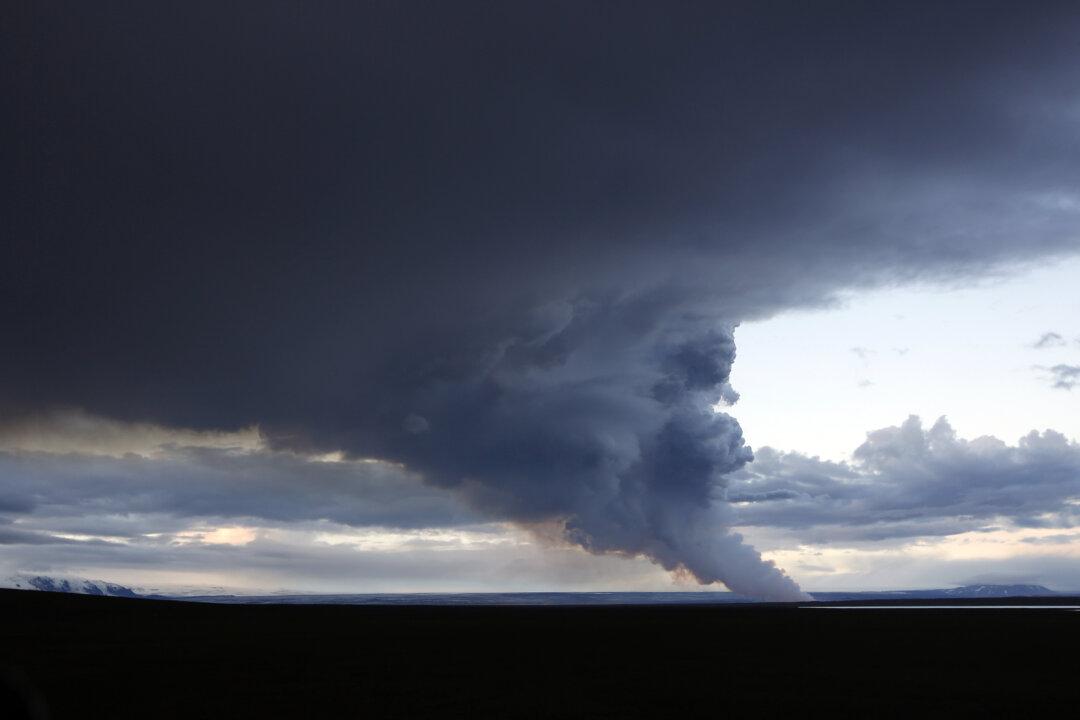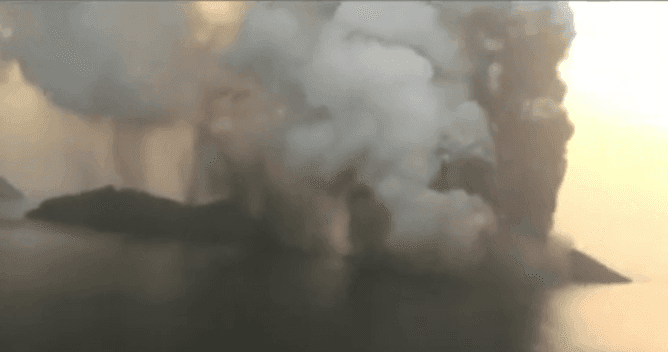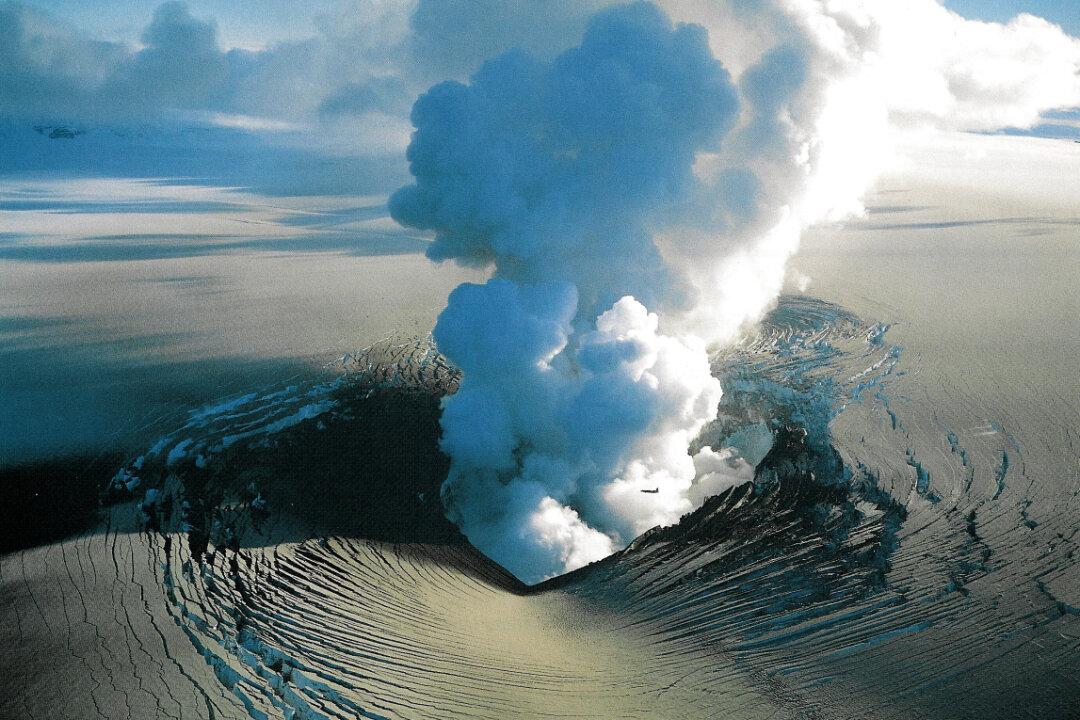The Bárðarbunga (or Bardarbunga) volcano has erupted, evoking memories of the 2010 Icelandic ash cloud that caused chaos across European and North American air routes. Dave McGarvie, a volcanologist at The Open University who has been in Iceland studying the latest eruption explains what’s going on.
What Has Been Happening?
The ice-covered Bárðarbunga volcano has a magma chamber beneath it, and measurements indicate that magma from this chamber has been escaping into a vertical underground crack which has migrated some 40 km north-east away from the chamber. We call this a dyke intrusion. Escape of magma from the chamber has removed support from the chamber roof which has collapsed to trigger the largest earthquakes in the area. At the far north-east tip of the dyke intrusion it managed to find a route to the surface on August 29 to produce a small eruption at the Holuhraun lava field that lasted only a few hours.
After a pause a larger eruption started in the same place on August 31, which continues at the time of writing. Both of these eruptions occurred along an ancient fissure that had erupted in 1797. So it looks like the magma in the new dyke intrusion met the old and cold 1797 dyke intrusion and followed this easy pathway to the surface. Had this not happened the new dyke intrusion might have kept moving to the north-east.
Holuhraun eruption on September 1, as captured by Simon Redfern.
What Is the Situation Right Now?
At the moment a vigorous eruption is taking place along a crack – about 1.5 km long – from which lava is fountaining. This is called a fissure eruption and these are common in Iceland. The lava fountains reach up to 70m high, and on collapsing they coalesce to form lava flows that are streaming away from the erupting fissure that currently covers an area of 10.8 square kilometres. An eruption plume of steam and volcanic gases has reached 6km into the atmosphere, but there is no ash.
The good news for Iceland is that despite Bárðarbunga being covered with ice, both eruptions took place in the an ice-free area which means that no ice is being melted and therefore there is no danger from flooding. And the good news for international air travel is that small fissure eruptions like these produce lots of lava but little or no ash, so any airspace closure is only local.
Lava flow on August 31, as captured by Simon Redfern.
Is This a Dangerous Eruption?
Not really. Near the eruption and downwind there will be a hazard from gases escaping from the eruption if they are in high enough concentrations – mostly sulphur dioxide and possibly also some fluorine and chlorine. Scientists working in certain areas have to wear gas masks. Although the lava is slow moving it is best to stay a few hundred metres away. Staying away from the strike of the erupting fissure is also a good idea in case it becomes longer.
The Icelandic scientists working in the area are familiar with this type of eruption and know the hazards and how to minimise the risks. But at present there are no plans to allow any one else into the area.
What Happens Next?
One big uncertainty is whether new magma is entering the system or not, and if so how much, and where, and at what rate. For example, if more magma is entering the system than is being erupted, then the dyke intrusion may start moving again or an eruption may happen elsewhere such as under the Bárðarbunga volcano itself, or the dyke intrusion may surface under the nearby glacier. Both of these would involve much melting of ice and would trigger floods (as magma can melt up to 14 times its own volume of ice).
Another uncertainty is that we don’t yet know whether this is an isolated event or whether it is the start of a prolonged episode involving multiple events of seismic unrest and magma movement. If it is the latter, then we have some idea of what to expect as there was a well-studied episode between 1975-84 at a volcano called Krafla in north Iceland. During this episode there were 21 events of seismic unrest, some of which were accompanied by dyke intrusions moving out from the magma chamber, a few of which broke to the surface and formed eruptions just like the present Holuhraun eruption.

A close up of lava from an eruption on Holuhraun, northwest of the Dyngjujoekull glacier in Iceland, on Sept. 1, 2014. (AP Photo/Eggert Johannesson)
We also don’t know whether the drainage of magma from the chamber beneath the Bárðarbunga volcano is going to trigger an eruption there. There is a lot of ice at this volcano because it contains a crater, or caldera, some 10km in diameter that is about 700m deep and filled with ice. So even a modest eruption here would generate a lot of meltwater.
What Is the Best-Case Scenario?
That the dyke intrusion stalls in the crust and cools, and the eruption at its tip ceases.
What Is the Worst-Case Scenario?
Unfortunately there is more than one. The first is that an eruption might start at the Bárðarbunga volcano itself, and there is a remote possibility that this could be a large explosive eruption producing an ash cloud. Fortunately because of the ash cloud produced during the Grímsvötn eruption of 2011 we have a fair idea of what this might look like and how best to minimise disruption to air travel. A reassuring fact is that lessons learned and changes made as a result of the Eyjafjallajökull 2010 eruption meant that despite erupting twice as much ash, disruption due to the Grímsvötn 2011 ash cloud was much less.
The second is that the dyke intrusion continues to the north-east and triggers an eruption at the Askja volcano. Askja last erupted in 1961, but its most notorious eruption was in 1875 when an explosive rhyolite eruption produced an ash cloud that spread over northern Europe. Rhyolite is a “sticky” magma type that fragments more easily into ash, hence has a higher potential to produce ash clouds that cause disruption to air travel.
However, we are unlikely to have a repeat of the 1875 eruption because there is probably not much rhyolite magma left, plus there is now a deep crater lake covering the 1875 eruption site. There remains the possibility that some ash could be produced if a dyke intrusion mixed with the remaining rhyolite magma and triggered an explosive eruption.
Have Lessons Been Learned?
The Bárðarbunga volcano didn’t get to be the second largest mountain in Iceland by sitting around doing nothing for centuries, so an eruption was inevitable, and recent signs of unrest were building towards this eruption. But as we have so little high-quality data from past eruptions to inform what might happen in the future, it is necessary to observe and gather high-quality data to learn what we can as fast as we can. This is what Icelandic scientists are excellent at doing.
I am aware that there is a lot of anxiety because the disruption caused by the Eyjafjallajökull 2010 eruption is still fresh in everyone’s minds. However, even if we had an exact repeat of this eruption tomorrow only a fraction of the flights would be cancelled. The decision makers have learned and moved on.
Dave McGarvie does not work for, consult to, own shares in or receive funding from any company or organisation that would benefit from this article, and has no relevant affiliations. This article was originally published on The Conversation. Read the original article.


